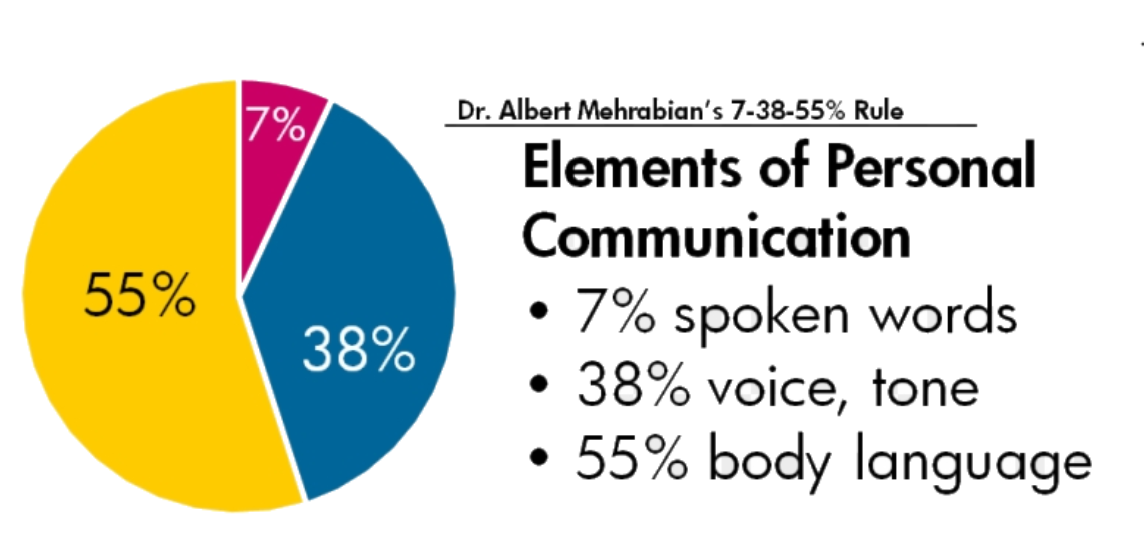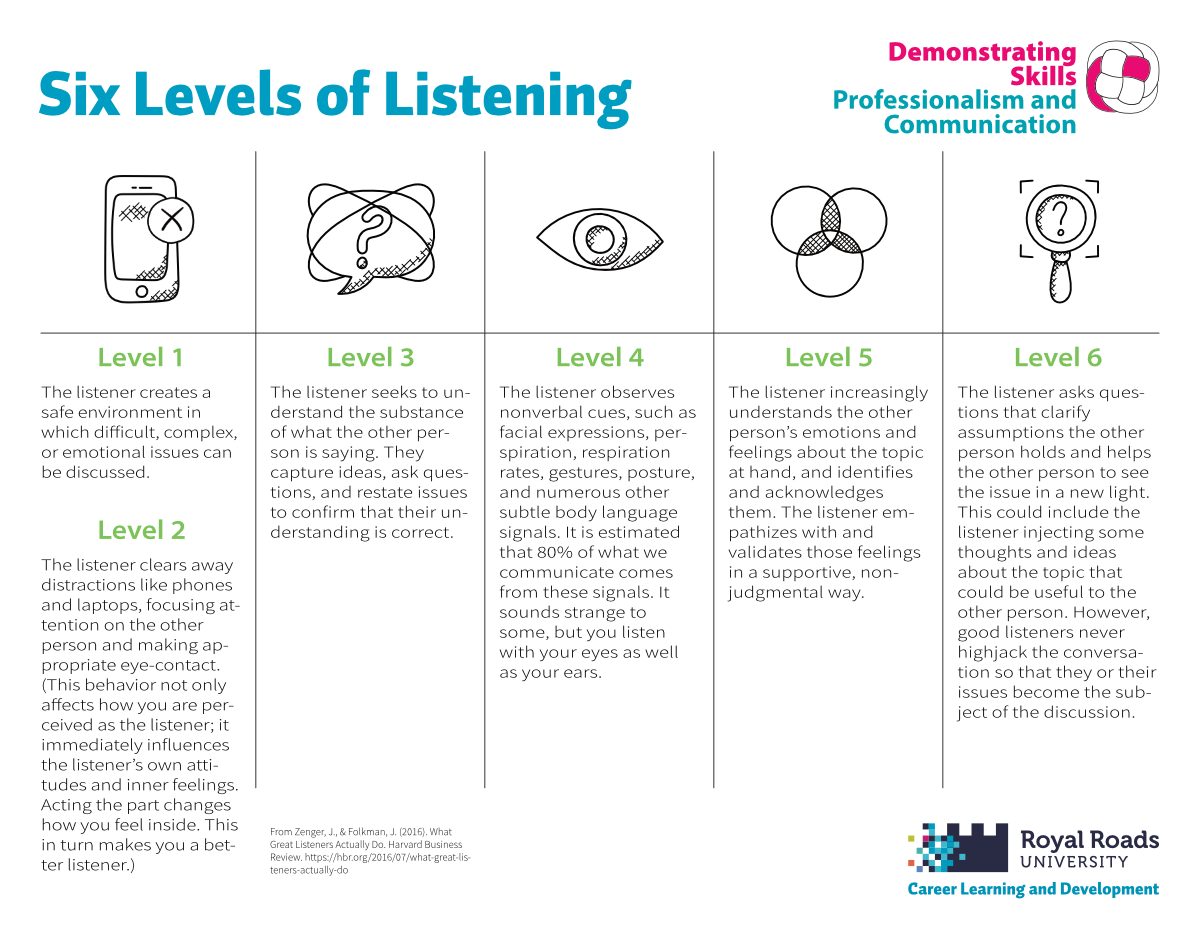Foundation: Professionalism and Communication
| Site: | RRU Open Educational Resources |
| Course: | Career Management Resources for Professionals |
| Book: | Foundation: Professionalism and Communication |
| Printed by: | Guest user |
| Date: | Saturday, 31 May 2025, 5:58 PM |
Professionalism
Although professionalism seems obvious, its importance should not be taken lightly. It can significantly influence your career in a positive or negative direction.
Professionalism is a complex, all-encompassing transferable skill; a combination of interpersonal skills, qualities, and behaviours.
From a Canadian anglophone perspective, professionalism can encompass:
- Knowledge and competence in your field,
- transferable skills, like communication—actively listening and reflecting—and Emotional Intelligence (EQ),
- qualities, such as integrity and ethics, and
- behaviours or conduct, for example taking responsibility for an error, or consistently following through on promises.
Additionally, nonverbal communication (body language) and paraverbal communication (voice language) are key components of professionalism as well.
The challenge with defining professionalism is that it can vary by occupation or industry, and definitely from country to country. What is deemed professional conduct in one country or cultural background might be inappropriate in another. Simple things such as exchanging business cards or punctuality (Uzialko, 2018) can spark irreversible consequences, if not demonstrated in a respectful (and informed) way.
What defines professionalism can change. For instance, Covid-19 shifted the standard way of greeting in Canada. Extending a firm handshake was customary. Zoom calls with incoming kids and/or pets in the video preview have become accepted and “normal”.
Professionalism can extend beyond your work identity. Your digital identity can be scrutinized and judged on its portrayal of your professionalism.
Portraying Canadian anglophone professionalism: competence, transferable skills, qualities, and conduct will impact your career. It looks like treating everyone with respect and empathy irrespective of their socio-economic background, gender, age, ethnicity or behaviour. Professionalism needs to be infused to resolve conflict, career search, and build your community network.
Communication
Although we communicate every day, it is a skill that we take for granted. Yet it is the bedrock of human interaction!
Communication and professionalism skills permeate every module throughout this Resource and have consequential outcomes.
These skills are imperative for building trust, community and relationships, conflict resolution, negotiation, and career search-obtaining a job and advancing your career. Conversely, on a grand scale if executed unskillfully can instigate wars. This is the power of communication!
While the content of your message is important, there are three key components that can potentially have a significant impact on your career positively or negatively:
- Nonverbal communication (body language),
- paraverbal communication, and
- human elements.
Nonverbal Communication
Nonverbal communication* (body language) includes:
- Facial expressions,
- Body movements,
- Gestures,
- Posture,
- Eye contact,
- Physical contact,
- Proxemics (physical distance).
* There are mixed viewpoints in terms of the percentage of how much our communication is nonverbal in comparison to other forms of communication. Birdwhistell was one of the pioneers to research nonverbal communication (Calero, 2005). While Mehrabrian’s 7% Rule took flight as a mainstream formula, there have been stated opinions that the statistics were taken out of context (Yaffe, 2011).

Image source: London Image Institute, 2020
Paraverbal Communication
How the message is delivered, paraverbal (voice language) is also an essential component of the communication process, which can include:
- Tone/pitch (e.g., monotonous or emphasis on a certain word),
- Speed/pace (e.g., fast, slow),
- Volume (e.g., loud, soft).
Suffice to say, nonverbal and paraverbal communication significantly influences the communication process and your career trajectory, despite the uncertainty of the 7% Rule.
Human Elements
Add any of the following elements to the communication process (this is not a comprehensive list) and the complexity intensifies:
- Cultural communication norms,
- Cultural beliefs and values,
- Personal beliefs and values,
- Gender,
- Situational context (e.g., casual to crisis or power differential-manager to employee or parent to child),
- Perceptions,
- Personality,
- Upbringing,
- Emotions (basic: anger, happy, sad, surprise, fear, and disgust),
- Generational - each generation may share common values and motivators: (Purdue Global, 2021)
- Baby Boomers: 1946–1964
- Generation X: 1965–1980
- Millennials: 1981-2000
- Generation Z: After 2000
In addition, there are a few miscellaneous factors that can also impact communication such as
- Cultural slang,
- Information overload,
- Noise.
Moreover, silence, talking about one’s self, building trust, and how disagreement is communicated (Meyer, 2015) are other ways in which cultural communication norms and interpretation can differ.
Watch the video, it summarizes what can negatively affect communication and some ways to prevent this from happening.
How miscommunication happens (and how to avoid it) - Katherine Hampsten (TED-Ed,2016) (4:32)
Communication Essentials
Communication can be easily compromised. Here are some tips to mitigate this:
Refrain from making assumptions. They can cause havoc with the communication process. Be with the individual in front of you. Be curious and respectful. Check in with the individual and ask open questions.
Strive to be consistent and congruent with your:
- message,
- nonverbal communication (body language), and
- paraverbal communication (how you deliver your message).
This instills trust (from a Canadian anglophone perspective)—trust builds collaborative working relationships and/or potential career opportunities. It is hard to trust a person when their body language and tone is incongruent to the content of their message,
Ramp up your radical listening (Heneghan, 2015) skills. Listen with empathy and ask open questions.
Zenger & Folkman describe six levels of listening in their article, What Great Listeners Actually Do :
Zenger & Folkman (2016, P. 4)
Scenario Analysis and Reflective Scenes
Now that we have a frame around professionalism and communication, the following pages contain a scenario and two video scenes to watch followed by prompting questions to answer. There are no right or wrong answers. Write your answers and reflections in the downloadable worksheet.
![]()
Download the Foundations of Professionalism and Communication
Worksheet
Scenario 1
A new supervisor was hired for the division and immediately implemented changes to the daily workings and procedures. No consultation meetings about current practices were conducted. One of the staff members asked the supervisor in the staff meeting about one of the changes and the response was “suck it up, buttercup.”
- What is your perception in terms of the supervisor’s professionalism in terms of communication, level of competence in leadership, personality characteristics, and conduct in this scenario?
- What are the human elements that influence this dynamic?
- How would you respond if you were the receiver of that message?
- How would you respond if you were a staff member witnessing this interchange?
Scene 1 (video)
Asian Jim - The Office (1:42)
Let's change the tone a bit for this scene. You may know of or watched the TV show, The Office. The scene is about a prank being played on the character, Dwight Schrute. (The Office, NBC, September 10, 2019)
- What did you observe about the nonverbal communication and proxemics (the physical distance) between each of the characters?
- What did you notice with each characters’ paraverbal communication (voice language - tone, speed, and volume) during the scene?
- The portrayal of mistrust emerged for both of the male characters during this scene, how did their nonverbal and paraverbal communication demonstrate this?
- What are the human elements that came into play during this scene?
Scene 2 (video)
A Conference Call in Real Life (3:28)
This is a fun scene of a mock conference call. (Tripp and Tyler, January 22, 2014)- How was miscommunication portrayed?
- What do you do to reduce miscommunication in your interactions with people?
- What were the nonverbal messages that were conveyed with reference to the older gentleman’s character?
- What do you notice when you are interrupted?
- How do you react when there is a lot of noise and you cannot understand the person’s message that they are trying to convey?
Conclusion
We can’t not communicate. We are continuously communicating—from the movement of our eyebrows, our posture, to the look in our eyes—even to how we breathe. Consequently, there is no shortage of ways for the communication process to break down.
Communication and professionalism are complex and the Canadian anglophone workplace has its own idiosyncrasies. The meaning behind the nonverbal and paraverbal communication, the content of the messages, and professional conduct can all have subtle and far-reaching distinctions. Each person, each culture, each circumstance can each have its own norms.
Demonstrating the combination of effective written, verbal, nonverbal, and paraverbal communication skills, professionalism, and EQ can influence a job offer or promotion, inspire positive working relationships, and/or resolve conflict.
Tip: Click exit book below to go back to the main page, or take this shortcut to move directly to the next module.
